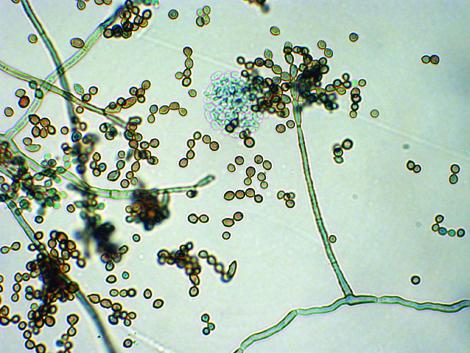Fonsecaea complex
Morphologically the genus Fonsecaea is defined by the presence of indistinct melanised conidiophores with blunt, scattered denticles bearing conidia singly or in short chains that eventually become branched.

Fonsecaea complex conidiophores and conidia.
de Hoog et al. (2004b) revised the genus on the basis of ITS sequencing data. Three species from humans are currently recognised, F. monophora, F. nubica, and F. pedrosoi, although they are morphologically indistinguishable (Najafzadeh et al. 2009, 2010b; Xi et al. 2009, de Hoog et al. 2015). All strains grow at 37C but not at 40C and the three species are recognised as aetiological agents of chromoblastomycosis.
RG-2 organism.
Morphological description:
Colonies are slow growing, flat to heaped and folded, suede-like to downy, olivaceous to black with black reverse. Conidiogenous cells pale olivaceous, arranged in loosely branched systems, with prominent denticles. Conidia pale olivaceous, clavate to ellipsoidal, in short chains, subhyaline, smooth and thin-walled, 3.5-5 x 1.5-2 µm.
Molecular identification:
ITS sequencing is recommended for species identification (Abliz et al. 2003, Najafzadeh et al. 2009, 2010b, Xi et al. 2009).
| Antifungal susceptibility: Fonsecaea pedrosoi (Australian national data); MIC µg/mL | |||||||||||
|---|---|---|---|---|---|---|---|---|---|---|---|
| No | ≤0.016 | 0.03 | 0.06 | 0.125 | 0.25 | 0.5 | 1 | 2 | 4 | ≥8 | |
| AmB | 11 | 1 | 1 | 5 | 3 | 1 | |||||
| ISAV | 5 | 1 | 2 | 2 | |||||||
| VORI | 11 | 1 | 4 | 5 | 1 | ||||||
| POSA | 11 | 2 | 7 | 2 | |||||||
| ITRA | 11 | 2 | 2 | 7 | |||||||
References:
McGinnis (1980), Dixon and Polak-Wyss (1991), de Hoog et al. (2000, 2004b, 2015), Abliz et al. 2003, Najafadeh et al. (2009, 2010a, 2010b).
